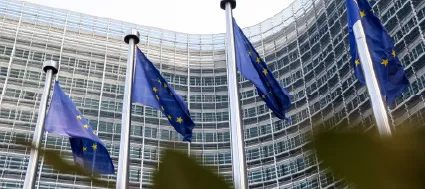EU Foreign Subsidies Regulation Guidelines
August 5, 2025
The European Union’s (EU’s) Foreign Subsidies Regulation (FSR) aims to prevent “foreign” (meaning non-EU) subsidies from distorting competition in the EU. The FSR imposed new notification requirements for M&A transactions and EU public tenders meeting certain thresholds and requires the Commission to block those that risk distorting the EU internal market (in the case of M&A transactions) or permit the submission of an unduly advantageous bid (in the case of public tenders), unless the negative effects are outweighed by potential benefits under the so-called “balancing test.” The FSR also empowers the Commission to require notification of transactions or bids not meeting the mandatory thresholds. The FSR requires the Commission to publish guidance on these subjects by January 2026.
The Commission has published draft guidelines (the Draft Guidelines), with a consultation open until September 11, 2025. Unfortunately, the Draft Guidelines provide scant assistance to potential transaction parties and bidders trying to assess their FSR exposure. In some respects, the Draft Guidelines provide less useful guidance than the very brief Staff Working Document published in July 2024. The Draft Guidelines and areas in which more concrete guidance is needed are discussed below.
Determining Whether Foreign Subsidies Distort the EU Internal Market
Article 4(1) FSR states that “a distortion in the internal market shall be deemed to exist where a foreign subsidy is liable to improve the competitive position of an undertaking in the internal market and where, in doing so, that foreign subsidy actually or potentially negatively affects competition in the internal market.” Thus, the Draft Guidelines note, a distortive foreign subsidy must meet two conditions: “first, it must be liable to improve the competitive position of the undertaking in the internal market; and second, as a result of the improvement of the competitive position of the undertaking, the foreign subsidy must actually or potentially negatively affect competition in the internal market.”
With respect to the first limb of the analysis, the Draft Guidelines note that a foreign subsidy is only liable to improve a company’s competitive position in the EU if it is likely to benefit the recipient’s EU activities, directly or indirectly. This is likely to be the case where foreign subsidies are used, or directed or intended to be used, in the EU. In other situations, the Commission will assess the likelihood that the undertaking will use foreign subsidies, fully or partially, to cross-subsidise its EU activities.
For example, where foreign subsidies are general or non-specific, the recipient remains free to use them in the EU. Where foreign subsidies are granted for activities outside the EU (e.g., to build a manufacturing plant, or to incentivise employment or to favour economic development, in a third country), those subsidies could nonetheless free up resources that the recipient could use in the EU. Absent “credible legal or economic factors which prevent or render unlikely that transfer, the Commission may still consider that the foreign subsidy potentially improves the undertaking’s competitive position in the internal market.”
Factors that could rule out cross-subsidization include a foreign subsidy’s design and conditions (e.g., compensating for a natural disaster); differences in the recipients’ shareholding structures (e.g., where subsidies are received by a joint venture with different shareholders); or third-party agreements (but not by-laws or internal policies), applicable laws (but not transfer pricing rules), or economic circumstances preventing cross-subsidization. Subsidies that are de minimis or insignificant in relation to the recipient’s EU activities are less likely to improve its competitive position.
With respect to the second limb, the Commission should show how the improvement of a subsidy recipient’s EU competitive position is likely to alter, or interfere with, competitive dynamics in the internal market to the detriment of other economic actors. This assessment includes two sides: first, whether the foreign subsidy is likely to affect the recipient’s behaviour in the EU, and second, a whether the changed behaviour is likely to alter, or interfere with, competitive dynamics to the detriment of other economic market actors.
The competitive impact of foreign subsidies may depend on their form, as well as market characteristics. Pricing or output decisions may be more impacted by foreign subsidies linked to activity levels, such as the production of a certain amount of products, reductions in social security payments, or reductions in CO2 emission tax or the cost of working capital. Recurring payments (e.g., periodically payable grants, recurrent loans, credit facilities) granted for the acquisition of a certain input may equally affect pricing incentives or output decisions. Transfers of fixed amounts (e.g., a one-off grant or loan for a fixed amount) may give recipients flexibility as to their use, including affecting pricing decisions. Other decisions, such as investments, expansions into new activities or acquisitions may stem from fixed subsidies, which may in turn indirectly affect prices. Expectations of financial support, such as guarantees or insurance priced below market level rates, may alter recipients’ attitude towards risk and induce them to take higher risks in the ordinary course of business or investment decisions. Where competition is mainly driven by price, foreign subsidies are more likely to be used to lower prices or to expand output. By contrast, in sectors driven by innovation and product or service diversification, recipients may direct subsidies to R&D.
Distortive foreign subsides in the M&A context. In the M&A context, foreign subsidies may distort the acquisition process itself or distort the internal market post-closing.
Subsidies directly facilitating a concentration may enable an acquirer to offer more attractive terms than rival bidders or deter other undertakings from submitting an offer or even entering negotiations. A subsidised investor enjoying a reduced cost of financing, all other factors being equal, can pay a higher price for the target than a non-subsidised rival, even if the latter brings the same or greater efficiencies to the business. Consequently, the foreign subsidy may reduce rivals’ growth opportunities or make their acquisitions more expensive, potentially limiting the possibility of efficiency gains (e.g., through achieving economies of scale or scope) and for innovation (e.g., through access to or combination of key technologies).
The Commission’s assessment includes identifying other actual or potential investors that could have been crowded out by the foreign subsidy, notably investors that submitted competing binding offers and investors that were likely discouraged or deterred by the subsidised rival. The second step consists of determining whether the offer submitted by the proposed acquirer is likely to have led to a distortive outcome (in this case, crowding out). Where the presence of a subsidised rival may have deterred other potential buyers., the Commission may benchmark the price offered against the price of similar past acquisitions. The Commission may also assess the valuation model used to determine whether the foreign subsidy is likely to lead to an offer that may have deterred other potential buyers.
The Draft Guidelines are less clear in the analysis of how foreign subsidies may distort competition post-closing. The Draft Guidelines refer to potential distortions of competition through foreign subsidies’ impact on operating decisions of the “subsidised undertaking,” presumably meaning the merged, post-closing entity. For example, the Draft Guidelines say that the merged entity may be able to offer customers lower prices or expand production or affect the merged entity’s investment decisions based on these subsidies. The Draft Guidelines do not discuss which subsidies are relevant for this analysis (only subsidies received pre-closing or also potential post-closing subsidies?) or relevant time limits.
Distortive foreign subsidies in the public procurement context. In public procurement procedures, the Commission’s assessment focuses on whether a foreign subsidy enables a bidder, actually or potentially, to submit an unduly advantageous tender in relation to the works, supplies and services concerned by the public procurement and whether the advantageous nature, such as its price, cannot plausibly be explained by other factors. In contrast to M&A notifications, the “notifying parties” in an FSR notification triggered by a public tender are limited to the bidding entity and other entities in the same chain of control; i.e., not “sister companies” within the same group. According to the Draft Guidelines, however, foreign subsidies granted to sister companies may also enable the bidder to submit an unduly advantageous tender and thus be caught by the FSR as discussed above.
In the public procurement context, the Commission’s analysis proceeds in three steps: (i) whether the tender is advantageous; (ii) whether the advantage is “undue” and (iii) whether there is a negative effect on competition in the EU. When assessing whether a tender is advantageous, the Commission considers whether a foreign subsidy may contribute to the bidder reducing the price, increasing the quality or offering better terms (e.g., delivery and lead times, warranties and after-sales support, payment terms, service level agreements, contractual flexibility, compliance with technical specifications, risk management, innovation, social and sustainability values).
Where the Commission finds a tender to be advantageous, it examines whether the advantage is “undue,” i.e., whether it stems from a foreign subsidy. The advantage is “due” if it can plausibly be justified by factors other than the foreign subsidy. Factors the bidder may adduce to justify that the advantage is “due” may include elements recognized under the EU public procurement directives to justify abnormally low tenders, such as the cost-effectiveness of the relevant production process, innovations or novel technical solutions, or exceptionally favourable conditions from which the economic operator benefits. The foreign subsidy need not be the only or even the main contributing factor for the tender’s advantageous nature for the tender to be found unduly advantageous.
Applying the “balancing test”
Under Article 6(1) FSR, the Commission may balance the negative effects of a foreign subsidy against the positive effects on the development of the relevant subsidised economic activity in the EU, while considering other positive effects of the foreign subsidy in relation to the relevant policy objectives. The balancing exercise can lead the conclusion that redressive measures or commitments are not necessary, where the positive effects of the foreign subsidy outweigh its negative effects. The more distortive the foreign subsidy is, the less likely it is that its negative effects will be outweighed by its positive effects. Thus, in the case of the foreign subsidies deemed most distortive, positive effects are less likely to outweigh negative effects.
The Commission has not yet had occasion to apply the balancing test in an actual investigation, but the Draft Guidelines discuss the Commission’s proposed methodology. The positive effects taken into consideration – which may differ from those originally intended by the country providing the subsidies -- should relate to the development of the subsidised economic activity in the EU and other positive effects, for example in relation to EU policy objectives. Relevant policy objectives could include a high level of environmental protection and social standards and the promotion of research and development, whether reflected in legal or non-binding acts, such as communications, guidelines, or other frameworks in relation to State aid, can also be relevant. The positive effects of a distortive foreign subsidy may also relate to non-EU policy objectives, to the extent they are relevant to the EU. Examples include promoting a high standard of environmental protection (climate change mitigation in a third country, protection of biodiversity, etc.) and social standards (including human rights protection), or the promotion of research and development activities that result in the availability of innovative products or technology in the EU.
For positive effects to be considered, they must be specific to the distortive foreign subsidy; i.e., absent the foreign subsidies, the positive effects would not occur, or otherwise not to the same degree. The person invoking the positive effects should be able to establish with a certain degree of likelihood that the foreign subsidies lead or are likely to lead to a change in the recipient’s behaviour resulting in those positive effects. Whether the positive effects are a deliberate consequence of the subsidy are accidental is generally not relevant under the balancing test.
Criteria for requiring notification of sub-threshold transactions and bids
The Commission enjoys a margin of discretion in deciding to whether to require an FSR notification of an M&A transaction or public tender that doesn’t meet the thresholds. The Commission can require notification of potentially subsidised M&A transactions (if they have not yet been implemented) or potentially subsidised bids (if the contract has not yet been awarded), if it considers that the concentration or bid would merit ex ante review given its impact in the EU. When the Commission requires the notification of an M&A transaction or public tender, such transaction or tender is deemed notifiable and subject to the normal FSR procedures.
Key takeaways
The Draft Guidelines cover the three topics on which the Commission is required to publish guidance by January 2026. In their current form, however, they provide little practical assistance to proposed M&A transaction parties and bidders in public tenders trying to assess their FSR exposure. Indeed, by advancing extremely broad interpretations of the FSR concept of foreign subsidies distorting the EU internal market, the Draft Guidelines are arguably less useful than the very brief 2024 Staff Working Document.
· Foreign subsidies not (directed or intended to be) used in the EU. The Draft Guidelines discuss many ways foreign subsidies received and used outside the EU could theoretically distort competition in the EU. In practice, however, such cross-subsidization is likely to be exceptional. The Staff Working Document noted that “in the case of a foreign subsidy that has been granted to a subsidiary not active in the Union, where that subsidy has been granted and effectively used in order to develop the local activity of the subsidiary in a third country, the relationship with the internal market is not apparent.” To assist notifying parties and improve its own efficiency, the final guidelines should identify factors that could warrant further investigation (e.g., the existence of intra-group loans from the recipient to a group member active in the EU).
· Foreign subsidies distorting competition post-closing. The Draft Guidelines do not discuss how the Commission plans to assess potential distortions from foreign subsidies post-transaction. The Staff Working Document noted that “while subsidies must be granted in the three years prior to the conclusion of the agreement, the announcement of the public bid, or the acquisition of a controlling interest in the target to fall within the scope of Article 19 [FSR], the distortion may not have materialised at the time that the concentration is completed. In that regard, it is not excluded that foreign subsidies lead to distortions with respect to the merged entity's activities.” The Staff Working Document thus acknowledged (i) that distortions arising post-merger are the exception and (ii) captured only where the effect of pre-closing subsidies “materialize” afterwards. This approach puts common-sense boundaries on an otherwise open-ended theory of harm.
· No guidance on complex foreign subsidies. The Draft Guidelines do not reflect the Commission’s experience with foreign subsidies that have proved challenging in its in-depth investigations so far, in particular bankruptcy protection and access to financing. The final guidelines should provide guidance on how it analyses these and other complex forms of foreign subsidy.
· No read-across to the Merger Regulation. The Draft Guidelines do not discuss the relationship between the review of M&A transactions under the FSR and review under the EU Merger Regulation, although many transactions triggering FSR review also trigger EU Merger Regulation review. More could and should be said about the read-across between the two review frameworks, e.g., in relation to the evidence relied upon, relevant time horizons for assessment and standards of proof. Similarly, the FSR’s balancing test closely resembles the EU Merger Regulation’s “efficiencies defence,” especially in relation to so-called “merger specificity” and “verifiability.” The Commission is also consulting on the EU Merger Regulation efficiencies defence.
· Inconsistency in the scope of public tender review. The Draft Guidelines surprisingly indicate that cross-subsidization of a bidder by non-EU sister companies can lead to a tender being considered unduly advantageous, like the assessment of distortive foreign subsidies in the M&A context. This approach seems inconsistent with the FSR’s text, as well as the Commission’s Form FS-PP for notification of in-scope public tenders.
You may also like








